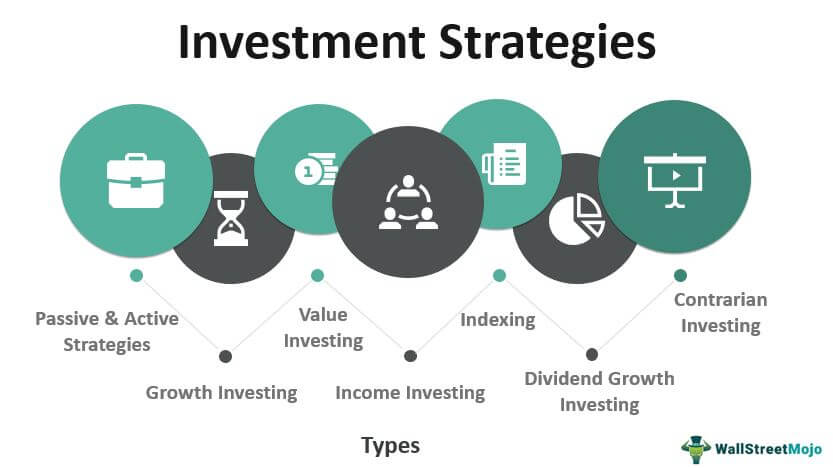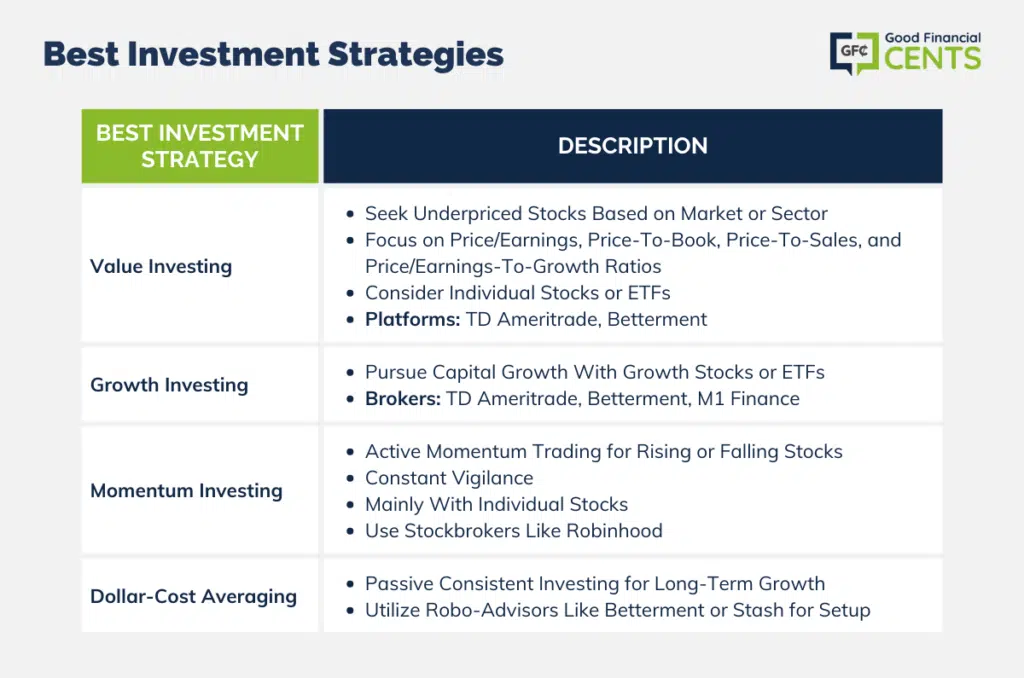The best investment strategies focus on diversification and long-term growth. Balancing risk and reward is crucial for success.
Investing can be intimidating, but with the right strategies, you can build wealth over time. Diversification spreads your investments across various asset classes, reducing risk. Long-term growth focuses on holding investments for years, capitalizing on market upswings. Both approaches require understanding market trends and making informed decisions.
Combining these strategies helps create a balanced portfolio. It’s important to stay informed and regularly review your investments to ensure they align with your financial goals. Remember, investing is a marathon, not a sprint. Patience and persistence are key to achieving financial success.
Introduction To Investment Strategies
Investing can seem confusing, but having a plan helps. An investment strategy is a plan to grow your money. It guides decisions and helps manage risks. Knowing different strategies makes investing clearer.<h3
Importance of Strategic Investing
Strategic investing is important for several reasons:
- Reduces Risk: A strategy helps avoid bad choices.
- Maximizes Returns: Smart plans can grow your money faster.
- Provides Clear Goals: A strategy keeps you focused.
- Adapts to Changes: Strategies can change with new information.
Investors often have different goals. Here are some common ones:
| Goal | Description |
|---|---|
| Retirement: | Saving money for life after work. |
| Education: | Building funds for schooling costs. |
| Buying a Home: | Saving for a house down payment. |
| Emergency Fund: | Setting aside money for urgent needs. |
Each goal needs a unique approach. Understanding your goals helps choose the right strategy.
Stock Market Investments
Investing in the stock market is a popular way to grow wealth. It allows you to own a part of a company. With the right strategy, stock investments can offer great returns.
Benefits Of Stock Investments
Stock investments offer many benefits. Here are some key points:
- High Returns: Stocks can provide high returns over time.
- Liquidity: Stocks are easy to buy and sell.
- Ownership: Owning stocks means owning a part of a company.
- Dividends: Many stocks pay dividends, providing regular income.
Risks And Mitigation
Stock investments come with risks. Understanding these risks is crucial. Here are some common risks and ways to mitigate them:
| Risk | Mitigation |
|---|---|
| Market Volatility | Diversify your portfolio to reduce impact. |
| Economic Downturns | Invest in stable sectors like utilities. |
| Company Performance | Research companies before investing. |
| Inflation | Invest in stocks that outpace inflation. |
Real Estate Investments
Real estate investments offer a reliable way to grow your wealth. They provide both short-term and long-term gains. This section explores the benefits and tips for real estate investments.
Long-term Gains
Investing in real estate can yield substantial long-term gains. Property values tend to increase over time. This appreciation in value boosts your investment returns.
Real estate also provides passive income through rental properties. Rent payments can cover your mortgage and generate extra cash. Over time, rental income can grow, enhancing your financial stability.
Equity in real estate grows as you pay off your mortgage. This equity can be leveraged for other investments. Real estate is a tangible asset, providing a sense of security.
Market Analysis Tips
Successful real estate investments require thorough market analysis. Here are some tips to help you:
- Location: Choose areas with high growth potential.
- Research: Investigate local market trends and property values.
- Rental Demand: Look for areas with high rental demand.
- Economic Factors: Consider local employment rates and economic stability.
Use online tools to gather data on property values and trends. Websites like Zillow and Realtor.com provide valuable insights.
| Tool | Purpose |
|---|---|
| Zillow | Property values and market trends |
| Realtor.com | Local real estate listings and trends |
Engage with local real estate agents. They offer firsthand knowledge of the market. Attend local property auctions to understand market prices and demand.
By following these tips, you can make informed real estate investment decisions. Real estate offers a blend of stability and growth, making it a wise investment choice.
Mutual Funds And Etfs
Investing in Mutual Funds and ETFs is a smart way to grow wealth. Both offer a blend of diversification and professional management. Mutual funds pool money from many investors to buy a range of securities. ETFs, or Exchange-Traded Funds, trade on stock exchanges. They also hold a variety of assets. Each has unique features that can help build a robust investment portfolio.
Diversification Benefits
Diversification spreads your money across many assets. This reduces risk by not putting all your eggs in one basket. Mutual funds and ETFs provide easy access to diversified portfolios.
Mutual Funds invest in a mix of stocks, bonds, or other securities. This allows even small investors to own a broad range of assets.
ETFs often track an index, like the S&P 500. This means you invest in many companies at once. Both options help balance risk and reward.
How To Choose The Right Fund
Choosing the right mutual fund or ETF depends on several factors. You should consider your investment goals and risk tolerance.
Here’s a simple guide to help you choose:
| Factor | Considerations |
|---|---|
| Investment Goals | Define short-term vs. long-term goals. |
| Risk Tolerance | Understand how much risk you can handle. |
| Fees | Check expense ratios and other costs. |
| Performance | Review past returns, but remember past performance is not a guarantee. |
Mutual Funds often have higher fees but provide active management. This can be beneficial if you seek expert guidance.
ETFs usually have lower fees and trade like stocks. They offer flexibility and cost-efficiency.
For a balanced approach, consider a mix of both mutual funds and ETFs. This strategy can optimize your portfolio for growth and stability.

Cryptocurrency Investments
Cryptocurrency investments have gained immense popularity in recent years. Many people are drawn to the potential high returns. Cryptocurrencies like Bitcoin, Ethereum, and others offer unique opportunities. Let’s explore the details of investing in cryptocurrencies.
Potential High Returns
Cryptocurrencies are known for their potential high returns. Early investors in Bitcoin saw massive profits. For example, Bitcoin’s price was $1 in 2010. It reached nearly $65,000 in 2021. This shows the potential for enormous gains.
Here is a table showing the growth of some popular cryptocurrencies:
| Cryptocurrency | 2010 Price | 2021 Price | Growth Percentage |
|---|---|---|---|
| Bitcoin | $1 | $65,000 | 6,499,900% |
| Ethereum | $0.30 | $4,300 | 1,433,233% |
| Litecoin | $0.06 | $300 | 499,900% |
Volatility And Risk Management
Cryptocurrency markets are highly volatile. Prices can change rapidly. This volatility brings both risks and opportunities. Proper risk management is crucial in cryptocurrency investments.
Here are some risk management strategies:
- Diversify your investments.
- Invest only what you can afford to lose.
- Keep updated with market trends.
- Use stop-loss orders to limit losses.
It is important to stay informed. Follow reputable news sources. Join cryptocurrency forums. Engage with the community. This helps in making informed decisions.

Credit: www.wallstreetmojo.com
Retirement Accounts
Retirement accounts are essential for long-term financial security. They offer various benefits, including tax advantages and employer contributions. Let’s explore two popular options: 401(k) and IRA. Understanding these can help you maximize your retirement savings.
401(k) And Ira Options
A 401(k) is a retirement account offered by many employers. It allows employees to save and invest a portion of their paycheck before taxes are taken out. Employers often match contributions, adding more value to your savings.
An IRA (Individual Retirement Account) is another option. It is not tied to your employer. You can open an IRA through a bank or brokerage. There are two types: Traditional and Roth. Each has its own tax benefits and rules.
Maximizing Tax Benefits
Both 401(k) and IRA accounts offer significant tax benefits. Understanding these can help you save more money.
- 401(k): Contributions are made with pre-tax dollars. This reduces your taxable income for the year.
- Traditional IRA: Contributions may be tax-deductible. This can lower your taxable income.
- Roth IRA: Contributions are made with after-tax dollars. Withdrawals during retirement are tax-free.
Here is a quick comparison of 401(k) and IRA tax benefits:
| Account Type | Contribution Type | Tax Benefit |
|---|---|---|
| 401(k) | Pre-tax | Reduces current taxable income |
| Traditional IRA | Pre-tax or after-tax | May reduce current taxable income |
| Roth IRA | After-tax | Tax-free withdrawals in retirement |
Remember, maximizing your contributions to these accounts can significantly boost your retirement savings. Take full advantage of employer matches and tax benefits. Start early and contribute regularly for the best results.
Alternative Investments
Alternative investments can be a smart way to diversify your portfolio. Unlike traditional stocks and bonds, these investments often offer unique returns. They may involve higher risks, but the potential rewards can be worth it. Let’s explore some popular types of alternative investments.
Art And Collectibles
Investing in art and collectibles can be very rewarding. Rare art pieces often appreciate in value over time. Collectibles like vintage cars, stamps, and coins can also be valuable. Here are some tips for investing in art and collectibles:
- Research the market thoroughly.
- Buy from reputable dealers.
- Ensure the authenticity of items.
- Consider storage and insurance costs.
A well-chosen piece of art can yield significant returns. Collectibles can also offer emotional satisfaction.
Peer-to-peer Lending
Peer-to-peer lending connects investors directly with borrowers. This eliminates the need for a traditional bank. Investors can earn interest on their money. Here are some advantages of peer-to-peer lending:
- Higher interest rates than savings accounts.
- Direct control over your investments.
- Diversified risk by lending small amounts to many borrowers.
Peer-to-peer lending platforms provide useful data on borrower reliability. Always review a borrower’s creditworthiness before lending.
Investing in alternative assets like art and peer-to-peer loans can diversify your portfolio. These investments can offer both financial and emotional rewards. Do your research and consider consulting a financial advisor.

Credit: www.goodfinancialcents.com
Creating A Balanced Portfolio
Building a balanced portfolio is key for long-term investment success. It helps spread risk and maximize returns. A well-balanced portfolio includes different asset classes. This ensures stability during market fluctuations.
Asset Allocation Strategies
Asset allocation is about dividing investments among various asset categories. Here are some common strategies:
- Conservative Strategy: Focus on bonds and cash. Ideal for risk-averse investors.
- Moderate Strategy: Mix of stocks, bonds, and cash. Suitable for balanced risk tolerance.
- Aggressive Strategy: Higher percentage in stocks. Best for high-risk, high-reward seekers.
Choosing the right strategy depends on your risk tolerance and investment goals. Consider your time horizon too. Longer investment periods allow for more aggressive strategies.
Periodic Portfolio Rebalancing
Periodic rebalancing ensures your portfolio stays aligned with your goals. This process involves adjusting asset allocation back to the original plan.
- Assess your current portfolio.
- Compare it with your target allocation.
- Sell over-performing assets.
- Buy under-performing assets.
Rebalancing can be done quarterly, semi-annually, or annually. This helps maintain desired risk levels and optimize returns.
| Period | Action |
|---|---|
| Quarterly | Review and adjust allocations. |
| Semi-Annually | Check performance and rebalance if needed. |
| Annually | Comprehensive review and rebalancing. |
Regular rebalancing is crucial for maintaining a balanced portfolio. It minimizes risk and ensures steady growth.
Conclusion And Next Steps
Investing can be a rewarding journey if approached with careful planning. Understanding the best investment strategies helps in building a strong financial future. This section guides you on setting realistic expectations and the importance of continuous learning.
Setting Realistic Expectations
Set achievable goals for your investments. Know that markets can be unpredictable. Expecting overnight success might lead to disappointment.
Here are some tips to set realistic expectations:
- Research thoroughly before investing.
- Understand the risks associated with each investment type.
- Set long-term goals instead of short-term gains.
Keeping these points in mind will help in managing your expectations effectively.
Continuous Learning And Adaptation
Investment strategies need constant updating. Markets change rapidly. Adapt to these changes for better results.
Consider the following steps for continuous learning:
- Read financial news regularly.
- Attend investment seminars and webinars.
- Follow expert blogs and podcasts.
Adapting to new trends and strategies will keep your investments on the right track.
In summary, setting realistic expectations and continuous learning are key. These steps ensure your investment journey remains smooth and fruitful.

Credit: barbarafriedbergpersonalfinance.com
Frequently Asked Questions
Which Investing Strategy Is The Best?
The best investing strategy varies per individual. Diversification, long-term holding, and regular contributions often yield strong results. Always consider your risk tolerance and financial goals. Consult with a financial advisor for personalized advice.
How To Make $1,000 A Month Investing?
To make $1,000 a month investing, diversify your portfolio. Focus on stocks, bonds, real estate, and mutual funds. Choose high-yield dividend stocks and reinvest earnings. Set realistic goals and monitor investments regularly. Consider consulting a financial advisor for personalized advice.
Consistent contributions and patience are key.
How To Invest $100 000 Wisely?
Diversify investments in stocks, bonds, real estate, and mutual funds. Consider low-cost index funds. Consult a financial advisor.
What Investment Strategy Has The Highest Return?
Stocks historically offer the highest returns. Investing in a diversified portfolio of stocks can maximize gains over time.
Conclusion
Choosing the right investment strategy is essential for financial growth. Diversify your portfolio to minimize risk. Regularly review your investments for optimal performance. Stay informed about market trends and adjust your strategies accordingly. With careful planning, you can achieve long-term financial success and security.
Start investing wisely today for a better tomorrow.

